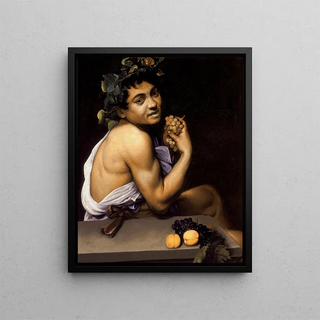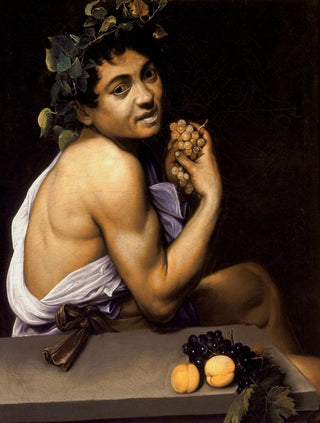Art print | The Young Sick Bacchus - Caravaggio


View from behind

Frame (optional)
In the fascinating world of baroque painting, "The Young Sick Bacchus" stands out as an emblematic work by the master Caravaggio. Created in the early 17th century, this canvas immerses us in a moment of introspection and vulnerability, where the god of wine, traditionally associated with joy and exuberance, reveals a darker facet of his existence. The viewer is immediately captivated by Bacchus's melancholic gaze, a reflection of human fragility in the face of illness and suffering. Through this artwork, Caravaggio invites us to contemplate the duality of life, where beauty and pain coexist.
Style and uniqueness of the work
Caravaggio's style is characterized by his bold use of chiaroscuro, a technique that creates a striking contrast between light and shadow. In "The Young Sick Bacchus," this approach is evident through light plays that highlight the delicate features of Bacchus's face, while the rest of the scene is shrouded in evocative darkness. The rich, deep colors, typical of the artist, add to the emotional intensity of the composition. The realism of the details, from the vine leaves adorning the god's head to the texture of his skin, demonstrates Caravaggio's meticulous observation. This realism, combined with palpable expressiveness, allows the viewer to feel the pain and anguish inhabiting the character. Bacchus's languid posture, lying on a simple bed, enhances this sense of decline, contrasting with the usual image of the jovial and triumphant god.
The artist and his influence
Michelangelo Merisi da Caravaggio, known as Caravaggio, is a central figure in art history, both for his innovative style and tumultuous life. Born in Milan in 1571, he revolutionized painting by incorporating elements of everyday life into his works, while exploring profound themes such as redemption, suffering, and mortality. His influence extends far beyond his era, inspiring generations of artists worldwide.

Matte finish

View from behind

Frame (optional)
In the fascinating world of baroque painting, "The Young Sick Bacchus" stands out as an emblematic work by the master Caravaggio. Created in the early 17th century, this canvas immerses us in a moment of introspection and vulnerability, where the god of wine, traditionally associated with joy and exuberance, reveals a darker facet of his existence. The viewer is immediately captivated by Bacchus's melancholic gaze, a reflection of human fragility in the face of illness and suffering. Through this artwork, Caravaggio invites us to contemplate the duality of life, where beauty and pain coexist.
Style and uniqueness of the work
Caravaggio's style is characterized by his bold use of chiaroscuro, a technique that creates a striking contrast between light and shadow. In "The Young Sick Bacchus," this approach is evident through light plays that highlight the delicate features of Bacchus's face, while the rest of the scene is shrouded in evocative darkness. The rich, deep colors, typical of the artist, add to the emotional intensity of the composition. The realism of the details, from the vine leaves adorning the god's head to the texture of his skin, demonstrates Caravaggio's meticulous observation. This realism, combined with palpable expressiveness, allows the viewer to feel the pain and anguish inhabiting the character. Bacchus's languid posture, lying on a simple bed, enhances this sense of decline, contrasting with the usual image of the jovial and triumphant god.
The artist and his influence
Michelangelo Merisi da Caravaggio, known as Caravaggio, is a central figure in art history, both for his innovative style and tumultuous life. Born in Milan in 1571, he revolutionized painting by incorporating elements of everyday life into his works, while exploring profound themes such as redemption, suffering, and mortality. His influence extends far beyond his era, inspiring generations of artists worldwide.






